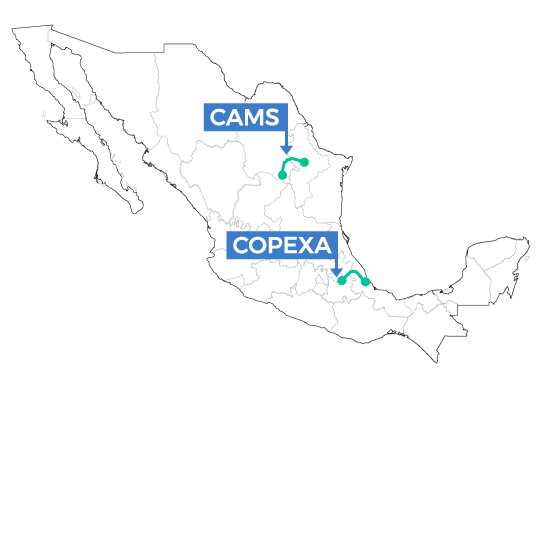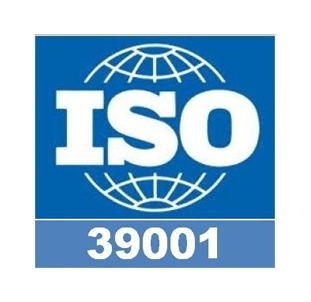
Highways were kept open and fully operational during the COVID-19 pandemic
The road network infrastructure transports 95.7% of passengers nationwide and 55.6% of freight volume.
163
2
12,980
RESUMEN ANUAL / SITUACIÓN NACIONAL / SECTOR CARRETERO /

For ROADIS in Mexico, like any company in the world and particularly those working with transport infrastructure, 2020 was affected by the COVID-19 pandemic.
Highways were kept open and fully operational at all times; and a significant investment was made through all types of measures to enable our teams to perform their duties safely.
Despite the 2-month hiatus imposed by the authorities to mitigate the effects of the pandemic and the additional measures that have had to be implemented to protect workers, we managed to carry out construction of the Santa Catarina Viaduct properly and on time. The project rounds off the year with better progress than scheduled.
While the decline in traffic associated with travel restrictions imposed by different authorities was significant, this is no less true of the recovery shown by both CAMS and COPEXA. Both have made a decisive contribution to the flow of goods into the country and to the United States, so that our company's finances have not suffered. Light transit is still in the recovery phase.
For 2021, we face several major challenges:
Continuing to adapt to the effects of the pandemic, mainly due to uncertainties about economic recovery, how user habits will have changed, and how to continue protecting our teams; continuing to build the Santa Catarina Viaduct properly and on time; and continuing to meet our goal of growing in the country.

2020 was a complex year for the Mexican economy, due to coronavirus. As a result of the pandemic, more than 2.4 million confirmed cases have already been reported, 220 thousand officially recognised deaths and up to 600 thousand deaths according to statistical projections.
In economic terms, the decreasing GDP trend recorded in 2019 was accentuated, leading to an annual fall of -8.5%, one of the highest rates globally. A GDP recovery of +5% for 2021 and +3% for 2022 is expected according to Bank of Mexico data. Inflation remained within the annual target range at 3.15%. The exchange rate averaged 21.5 pesos per dollar, with a maximum of 24 and a minimum of 19 pesos per unit. Foreign Direct Investment (FDI) flows dropped by -11.7% annually (from $32.921 billion in 2019 to $29.079 billion in 2020). Of the total FDI, new investments fell 50%, and flows were only maintained thanks to inter-company accounts. In a context of low FDI, ROADIS investment in the Santa Catarina Viaduct has been significant for the Federal Administration and sets a positive precedent for the company in our future investment plans.
The main economic sectors, such as oil exports and tourism, had worrying figures: 17 billion dollars and 11 billion dollars, respectively. They could barely be mitigated by the recovery of the automotive sector - which generated 123 billion dollars - and remittances from Mexicans abroad, which contributed almost 41 billion dollars last year.
Public investment for the road sector remains low, with the federal government enthusiastically open to private investment via road division and unsolicited proposals. The priority of government spending is rural roads.
The road network infrastructure transports 95.7% of passengers nationwide and 55.6% of freight volume. The inventory of the National Road Network as of December 2019 is presented in the Statistics Appendix of the Second Government Report 2018-2024:
According to the 2020 Progress and Results Report of the Ministry of Communications and Transport (SCT), at the end of 2020 an additional 143.8 km was recorded in the construction and modernisation of federal roads.

Between September 2019 and June 2020, the management and preparation of the first package of five road divisions was completed for 22.628 billion pesos (~ 1.135 billion USD) for a total length of 242.1 km.
In the same period, a second division package was managed for nine projects for 18.919 billion pesos (~ 949 million USD) and 142.6 km.
In November 2020, the Federal Congress approved the SCT budget for 2021. The amount was 55.920 billion pesos (~ 2.804 billion USD), similar to the previous year, in real terms. The budget for the road infrastructure sector was 33.846 billion pesos (~ 1.697 billion USD), 6% less compared to the 2020 budget.
A total of 2.465 billion pesos (~ 124 million USD) was defined for the construction and modernisation of 68 kilometres of the federal network, a figure that is 52% less than 2020. 2.735 billion pesos (~ 137 million USD) was approved to release road rights; 550.6 million pesos (~ 28 million USD) for pre-investment studies; 4.149 billion pesos (~ 208 million USD) for service provision projects and 116.8 million pesos (~ 6 million USD) for a Public-Private Partnership (PPP) project.
For rural road infrastructure, 6.792 billion pesos (~341 million USD) were assigned for the construction and modernization of 210 kilometres, as well as the conservation and reconstruction of 1,180 km and the completion of technical studies for 2,200 km.
A total of 8.231 billion pesos (~ 413 million USD) were allocated for the conservation and maintenance of the national road network.
Finally, 6.945 billion pesos (~ 348 million USD) will be used to cover 10 Public-Private Partnership (PPP) Projects, with an estimated target of 1,755 kilometres on the stretches of road.
HOW DO WE CREATE VALUE IN OUR COMMUNITIES?
CAMS and COPEXA, our two toll highways in Mexico, have contributed to the development of the communities in which they operate through the creation of a significant number of direct and indirect jobs. In addition, these two highways provide their users a wide variety of services, always ensuring their comfort, safety and the quality of the road.
The free services provided on the highway include: roadside assistance in case of accident, towing service, a 24/7 emergency service and SOS phones located at strategic points along the highways.
Various CSR actions have been carried out in CAMS and COPEXA in order to maintain our commitment to community development.
Awards and certifications received by the SBU



Associations to which the SBU belongs

AMCIV
Asociación Mexicana de Concesionarios de Infraestructura Vial, which brings together the main highway concession holders in Mexico.
Other ROADIS projects










